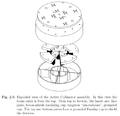Difference between revisions of "JB Undergraduate Research Progress"
Bartolotta (talk | contribs) |
Bartolotta (talk | contribs) |
||
| Line 1: | Line 1: | ||
| − | This page gives an overview of the work I have done under the supervision of Dr. Richard Jones from | + | This page gives an overview of the work I have done under the supervision of Dr. Richard Jones from May 2013 to the present time. |
==Finalizing summer work== | ==Finalizing summer work== | ||
Revision as of 04:06, 11 January 2014
This page gives an overview of the work I have done under the supervision of Dr. Richard Jones from May 2013 to the present time.
Finalizing summer work
I worked in the lab as a student worker during the summer of 2013. My day to day summer log can be found here. I spent my time working on a proposal for a chilled water line for the servers in P403. I finalized this document in the beginning of the Fall 2013 semester. It can be found here.
Familiarizing myself with the active collimator
When I first gained access to the active collimator, I took it apart in order to understand its structure. Below are pictures that I took upon its disassembly.
I read Igor Senderovich's PhD thesis very carefully in order to understand the active collimator's purpose and how it works. This project is largely based on Senderovich's work from his time under Dr. Jones's supervision. The active collimator has been quality assured by Alex Barnes, James McIntyre, and Dr. Jones. A detailed PowerPoint regarding the use of the active collimator in the GlueX experiment was written by Dr. Jones, Igor Senderovich, and Ann Marie Carroll for an APS/DNP meeting in October of 2012.
Data Acquisition
My research thus far has been focused on examining the electronic properties of the active collimator. I spent a few weeks working on capturing waveforms with a Tektronix TDS 2024 Digital Storage Oscilloscope by tapping the pin cushions with a piece of metal that I was holding in order to build up a charge on the cushion. I connected each of the tungsten pin cushions within the active collimator to cables with an RF coaxial adapter input which was connected to the face plate and a BNC output which was connected to a PMT-5R amplifier. I used a F-100PS 15 Volt DC Power Supply to power the amplifiers. However, I did not have control over the amplifier's gain setting with this setup.
Igor developed a data acquisition LabView program for the active collimator. The program allows the user to vary the gain setting on the amplifiers from 10^6 to 10^12 in powers of ten, record the potential difference across each of the tungsten pin cushions at a frequency of about 800 data points per second, and calculate Fourier transforms on the received signals. The program is run on a PC that Alex Barnes and I built which contains a data acquisition card. Below are pictures of the pieces of equipment used for data acquisition.
Data Analysis
I have been using the C++ based program ROOT in order to analyze the data obtained from the active collimator.
Trip to JLab
I traveled to Jefferson Lab in Newport News, Virginia from January 4th to January 15th during my 2014 winter break. My day to day log for my trip to Jefferson Lab can be found here (search "JLab trip"). I have also created a travel expenses spreadsheet and an inventory spreadsheet.
Tour of Hall D
On January 10th, Sascha Somov took me to the accelerator site for a tour of the Hall D facility. Below are some pictures I took during the tour.
The actcol-station is set up in F117 of the CEBAF building at Jefferson Lab. I have created a wiki page that teaches a user how to operate the station.





























